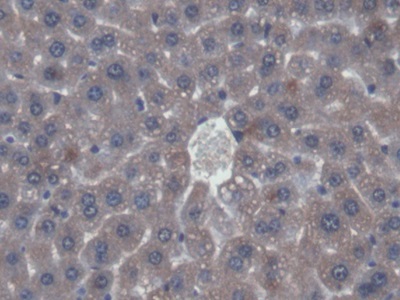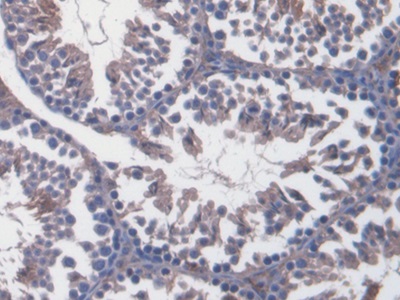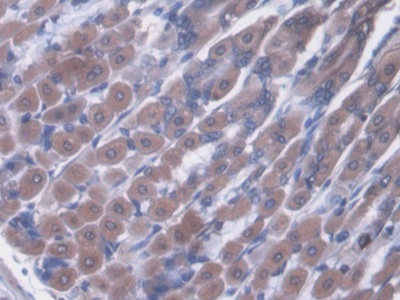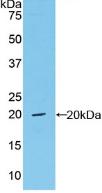Polyclonal Antibody to Von Willebrand Factor (vWF) 

F8VWF; VWD; von Willebrand antigen 2
Overview
Properties
- Product No.PAA833Mu01
- Organism SpeciesMus musculus (Mouse) Same name, Different species.
- ApplicationsIHC
If the antibody is used in flow cytometry, please check FCM antibodies.
Research use only - DownloadInstruction Manual
- CategorySignal transductionHematology
- SourcePolyclonal antibody preparation, Host Rabbit
- Ig Type IgG, Potency n/a
- PurificationAntigen-specific affinity chromatography followed by Protein A affinity chromatography
- LabelNone
- Immunogen RPA833Mu01-Recombinant Von Willebrand Factor (vWF)
- Buffer Formulation0.01M PBS, pH7.4, containing 0.05% Proclin-300, 50% glycerol.
- TraitsLiquid, Concentration 0.5mg/mL
Sign into your account
Share a new citation as an author
Upload your experimental result
Review

Contact us
Please fill in the blank.
Specifity
The antibody is a rabbit polyclonal antibody raised against vWF. It has been selected for its ability to recognize vWF in immunohistochemical staining and western blotting.
Usage
Western blotting: 0.01-2µg/mL;
Immunohistochemistry: 5-20µg/mL;
Immunocytochemistry: 5-20µg/mL;
Optimal working dilutions must be determined by end user.
Storage
Store at 4°C for frequent use. Stored at -20°C in a manual defrost freezer for two year without detectable loss of activity. Avoid repeated freeze-thaw cycles.
Stability
The thermal stability is described by the loss rate. The loss rate was determined by accelerated thermal degradation test, that is, incubate the protein at 37°C for 48h, and no obvious degradation and precipitation were observed. The loss rate is less than 5% within the expiration date under appropriate storage condition.
Giveaways
Increment services
-
 Antibody Labeling Customized Service
Antibody Labeling Customized Service
-
 Protein A/G Purification Column
Protein A/G Purification Column
-
 Staining Solution for Cells and Tissue
Staining Solution for Cells and Tissue
-
 Positive Control for Antibody
Positive Control for Antibody
-
 Tissue/Sections Customized Service
Tissue/Sections Customized Service
-
 Phosphorylated Antibody Customized Service
Phosphorylated Antibody Customized Service
-
 Western Blot (WB) Experiment Service
Western Blot (WB) Experiment Service
-
 Immunohistochemistry (IHC) Experiment Service
Immunohistochemistry (IHC) Experiment Service
-
 Immunocytochemistry (ICC) Experiment Service
Immunocytochemistry (ICC) Experiment Service
-
 Flow Cytometry (FCM) Experiment Service
Flow Cytometry (FCM) Experiment Service
-
 Immunoprecipitation (IP) Experiment Service
Immunoprecipitation (IP) Experiment Service
-
 Immunofluorescence (IF) Experiment Service
Immunofluorescence (IF) Experiment Service
-
 Buffer
Buffer
-
 DAB Chromogen Kit
DAB Chromogen Kit
-
 SABC Kit
SABC Kit
-
 Long-arm Biotin Labeling Kit
Long-arm Biotin Labeling Kit
-
 Real Time PCR Experimental Service
Real Time PCR Experimental Service
Citations
- Amorphous silica nanoparticles impair vascular homeostasis and induce systemic inflammationPubmed:Pmc4047982
- Systemic and Flap Inflammatory Response Associates with Thrombosis in Flap Venous CrisisPubmed:25448261
- Short-Term Nose-Only Water-Pipe (Shisha) Smoking Exposure Accelerates Coagulation and Causes Cardiac Inflammation and Oxidative Stress in MicePubmed:25634761
- Blood pH in coronary artery microthrombosis of ratsPubMed: 26522304
- Subchronic Toxicity and Cardiovascular Responses in Spontaneously Hypertensive Rats after Exposure to Multiwalled Carbon Nanotubes by Intratracheal InstillationPubMed: 25580880
- Differential integrative omic analysis for mechanism insights and biomarker discovery of abnormal Savda syndrome and its unique Munziq prescriptionPubmed:27296761
- Circulating endothelial cells, circulating endothelial progenitor cells, and von Willebrand factor in pregnancies complicated by hypertensive disordersdoi:10.1111
- Low-Dose Sodium Nitrite Fluid Resuscitation Prevents Lethality From Crush Syndrome by Improving Nitric Oxide Consumption and Preventing Myoglobin Cytotoxicity in Kidney in A Rat Model.pubmed:27941593
- The directional migration and differentiation of mesenchymal stem cells toward vascular endothelial cells stimulated by biphasic calcium phosphate ceramic10.1093/rb/rbx028
- Early prognostic factors in septic shock cancer patients: a prospective study with a proteomic approachPubmed:29315472
- Relationship between the von Willebrand Factor Plasma Concentration and Ultrasonographic Doppler Findings in Pregnancies Complicated by Hypertensive …Pubmed:29621786
- Role of Pigment Epithelium-Derived Factor in Arsenic-Induced Vascular Endothelial Dysfunction in a Rat ModelPubmed: 30392020
- Risk stratification and prognostic evaluation of endothelial cell‑specific molecule1, von Willebrand factor, and a disintegrin‑like and metalloprotease with …
- Association between Upper-airway Surgery and Ameliorative Risk Markers of endothelial function in obstructive Sleep ApneaPubmed: 31882827
- Waterpipe Tobacco Smoke Inhalation Triggers Thrombogenicity, Cardiac Inflammation and Oxidative Stress in Mice: Effects of FlavouringPubmed: 32075078
- Pigment epithelium-derived factor (PEDF) ameliorates arsenic-induced vascular endothelial dysfunction in rats and toxicity in endothelial EA. hy926 cellsPubmed: 32315827
- Xiaoyukang Jiaonang Promotes the Degradation of Hypoxia-Inducible Factor 1α and Antiangiogenesis and Anti-Inflammation in Chronic Subdural Hematoma …Pubmed: 32228124
- Enhanced Fibrin-Lysis in Grade-1 Dengue Haemorrhagic Fever
- Ad hatoda Vasica: a potential ayurvedic intervention against COVID-19 associated impaired immune response and hypoxia-inflammation phenotype
- Investigating the Multi-Faceted Nature of Radiation-Induced Coagulopathies in a G?ttingen Minipig Model of Hematopoietic Acute Radiation Syndrome34019667
- Preservation of renal endothelial integrity and reduction of renal edema by aprotinin does not preserve renal perfusion and function following experimental …34169407
- Salvianolic acid B improves the survival rate, acute kidney dysfunction, inflammation and NETosis‑mediated antibacterial action in a crush syndrome rat modelPubmed:35386617









